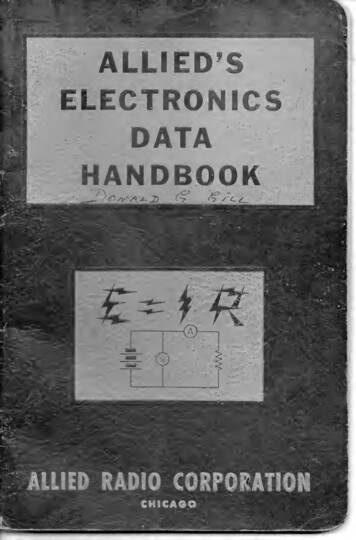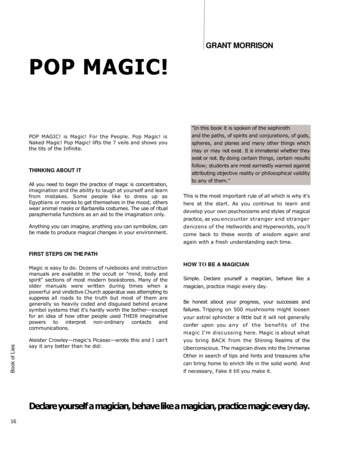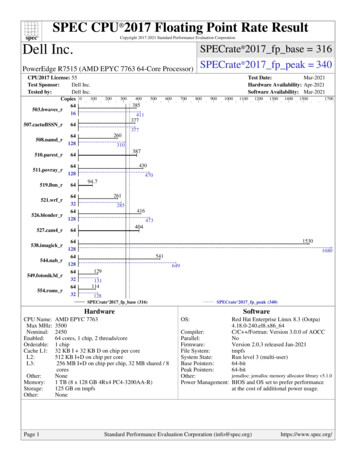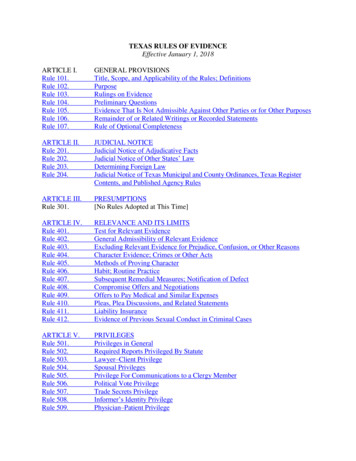
Transcription
CONCEPTA Magic Ratio Rule forBeginners: a Chemist’s Guideto Quantum Interference inMoleculesColin J. Lambert,[b] and Shi-Xia Liu*[a][a][b]Title(s), Initial(s), Surname(s) of Author(s) including CorrespondingAuthor(s)DepartmentInstitutionAddress 1E-mail:Title(s), Initial(s), Surname(s) of Author(s)DepartmentInstitutionAddress 2Supporting information for this article is given via a link at the end ofthe document.((Please delete this text if not appropriate))
CONCEPTAbstract: This overview will give a glimpse into chemical designprinciples for gating quantum interference (QI) effects in nanoscaledevices. Direct observation of room temperature QI in singlemolecule junctions has stimulated growing interest in fabrication oftailor-made molecular electronic devices. Herein, we outline a newconceptual advance in the scientific understanding and technologicalknow-how necessary to control QI effects in single molecules bychemical modification. We start by discussing QI from a chemicalviewpoint and then describe a new magic ratio rule (MRR), whichcaptures a minimal description of connectivity-driven chargetransport and provides a useful starting point for chemists to designappropriate molecules for molecular electronics with desiredfunctions. The MRR predicts conductance ratios, which are solelydetermined by QI within the core of polycyclic aromatichydrocarbons (PAHs). The manifestations of QI and related quantumcircuit rules for materials discovery are direct consequences of thekey concepts of weak coupling, locality, connectivity, mid-gaptransport and phase coherence in single-molecule junctions.IntroductionHow does electricity flow through molecules? To answer thisquestion experimentally, strategies are need for contactingsingle molecules to source and drain electrodes separated by ananogap and then passing a current from the source to the drainvia the molecule.[1] In the literature, nanogaps have beenrealised using scanning-tunnelling-microscopy-based breakjunctions, conducting probe atomic force microscopy breakjunctions and mechanically controllable break junctions.[1g, 1h, 2]Fundamental studies of charge transport properties of singlemolecules trapped between two metallic electrodes havedemonstrated clear correlations between molecular structureand function.[3] Scalability remains one of great challenges,which is of high importance for the fabrication of practicalmolecular electronic devices. Consequently, silicon-basedplatforms have been developed,[4] but so far such technologiesremain in their infancy. To circumvent some limitations ofmetallic and silicon-based electrodes, single molecule junctionshave been fabricated between carbon-based electrodes such ascarbon nanotubes[5] and graphene.[6] In particular, grapheneelectroburnt junctions have been shown to deliver stableelectrode gaps below 5 nm,[7] which allow electrostatic gatingthrough buried or side gates. For the purpose of attaching[a][b]Dr. S.-X. LiuDepartment of Chemistry and BiochemistryUniversity of BernFreiestrasse 3, CH-3012 BernE-mail: liu@dcb.unibe.chProf. C. J. LambertQuantum Technology Centre, Physics DepartmentLancaster UniversityLancaster LA1 4YB, UKE-mail: c.lambert@lancaster.ac.ukSupporting information for this article is given via a link at the end ofthe document.((Please delete this text if not appropriate))molecules to different types of electrodes, the ends of themolecule should be terminated by ‘anchor groups’, which bindopposite ends of the molecule to the source and drainelectrodes. Over the last two decades, a variety of anchorgroups have been explored.[1a, 1e, 8] For instance, thiols,[9]pyridines,[10] amines,[11] methyl sulfides[12] and direct gold-carbonbonds[13] have been utilised in metal-molecule-metal junctions.Amine-terminated molecules can bridge nanogaps betweencarboxylic acid-functionalized carbon nanotubes[5b] whilearomatic planar anchor groups including anthracene [7a] andpyrene[14] are of interest due to their binding ability to grapheneelectrodes via π-π stacking and van der Waals interactions.Having established stable anchors to the electrodes, thepassage of electricity through single molecules requires makingchoices for the remainder of the molecule, which typicallyinvolves a central aromatic functional subunit attached to theanchor groups via spacers. Clearly, many different factorsincluding anchor groups, molecular lengths, the nature ofspacers and electronic structures of the aromatic subunits, affectdrastically the charge transport properties of molecular devices.In most cases, charge transport measurements are interpretedin terms of an off-resonant tunneling process that disregardsquantum interference (QI) effects.During the past few years, a large body of evidence hasaccumulated, which demonstrates that the passage of electricitythrough molecules is controlled by QI, even at roomtemperature,[15] and furthermore, QI can be exploited to controland enhance electrical and thermoelectrical properties of singlemolecules.[15d, 16] As a consequence, fine tuning of QI effects hasattracted a great deal of interest, both theoretically andexperimentally. Despite efforts to control the flow of charge atthe quantum level by modifying electronic structure andmolecular topology through organic synthesis, a directcorrelation between QI and structure remains ambiguous. It isboth timely and desirable to develop qualitative design rules fortailor-made single-molecule devices. Recently we developed anew “magic ratio rule” (MRR), which captures the role ofconnectivity in determining the charge transport properties ofpolycyclic aromatic hydrocarbons (PAHs) as well as theirheteroatom-substituted systems.[15b, 17] Evidence for QI is mostlyindirect and obtained by comparing transport properties ofhomologous series of related molecules,[15f-h] rather than usingexternal electric, magnetic or mechanical gating to control QIwithin a single molecule. In other examples, direct evidence ofroom temperature QI is obtained by manipulating the chargestate of a molecule in three-terminal devices or inelectrochemical environments.[15j] Before discussing theseexamples in more detail, we start by describing some basicconcepts of QI, which are relevant to the flow of electricity andheat. We present these concepts using a language more familiarto chemists than to physicists, emphasizing the differencebetween inter-orbital and intra-orbital QI. One aim of thefollowing text is to introduce Green’s functions for molecularscale transport in an intuitive and non-mathematical manner.Ultimately, QI effects are related to the shapes and energies ofthe molecular orbitals, and can therefore be manipulated bychemical design. However when many orbitals contribute,
CONCEPTfocusing on the contributions from individual orbitals becomescumbersome and it is fruitful to introduce new ‘magic ratio rules’,which account for many orbital QI effects in a simple andintuitive manner.Green’s functions for beginnersOf course in single molecules, QI is everywhere. Molecularorbitals (MOs) such as the highest occupied molecular orbital(HOMO) of pyrene (see Fig. 1) are obtained by solving theSchrödinger equation and are themselves a result ofconstructive QI. In what follows, we shall refer to this as “intraorbital QI.” Our task is to understand the relationship betweenthese MOs and the flow of electricity, and to understand howthey can be manipulated by chemical design to optimisetransport properties. The isosurface in Fig. 1 shows that theHOMO has regions of positive amplitude (coloured red) andregions of negative sign (coloured blue). Furthermore it hasregions of high amplitude such as the regions of space r5 and r8near atoms 5 and 8, and regions of low amplitude such as theregion of space r2 near atom 2. Such MOs are analogous to thewave patterns in your coffee cup, which occur when the cup isplaced on a vibrating table whilst travelling on a train, or a soundwave pattern formed by an echo in an empty auditorium, or theshape of water waves created in a wave tank.Figure 1. A lattice representation and frontier molecular orbitals of pyrene.The basic ideas used to relate MOs of isolated molecules tothe flow of electricity when located within a junction, wereintroduced in ref 1f, where the key concepts of weak coupling locality connectivity mid-gap transport phase coherencewere utilised.To highlight the relevance of ‘weak coupling,’ we note that if anaromatic molecule such as pyrene is strongly coupled to twoelectrodes, then the identity of the molecule is lost and transportproperties can only be computed by treating the molecule,electrodes and their couplings on an equal footing in a holisticmanner. However if a central aromatic subunit such as pyrene isweakly coupled to the anchor groups via spacers such asacetylene, then the characteristics of the pyrene are preservedand the MOs of isolated pyrene can be used to predict transportproperties. This ‘weak coupling’ concept is crucial to thediscussion below.The concept of ‘locality’ recognises that when a current flowsthrough an aromatic subunit, the points of entry and exit arelocalised in space. For example in Fig. 1, the current enters inthe region of space in the vicinity of position ri and exits from theregion of space near ri’.The concept of ‘connectivity’ recognises that spacers can beattached to different parts of a central subunit with atomicaccuracy and therefore it is of interest to examine how the flowof electricity depends on the choice of connectivity to the centralsubunit. For example if σii’ is the electrical conductance of asingle-molecule junction when the current enters and leaves asubunit at locations ri and ri’, and σjj’ is the electrical conductancewhen the current enters and leaves at locations rj and rj’, then itis of interest to examine conductance ratios such as σii’ / σjj’.Remarkably, if the coupling to the central subunit is weak, thensuch ratios are largely determined by MOs of the isolatedsubunit.The concept of ‘mid-gap transport’ is an acceptance of the factthat unless a molecular junction is externally gated by anelectrochemical environment or an electrostatic gate, then theenergy E of electrons flowing through the molecule is usuallylocated in the vicinity of the centre of the HOMO-LUMO gap andtherefore transport takes place in the co-tunnelling regime. Inother words, transport is usually ‘off-resonance’.Finally, the concept of ‘phase coherence’ recognises that in thisco-tunnelling regime, the phase of electrons is usually preservedas they pass through a molecule and therefore transport iscontrolled by superpositions of MOs of the type shown in Fig. 1.When these conditions are satisfied, electricity flow can beunderstood using the intuitive picture described below. Once theintuitive picture is established, one can systematically discusswhat happens when each of the above conditions is relaxed.To understand the relationship between MOs and electricalconductance, consider a fictitious subunit, which possesses onlya single MO, which we denote ψH(r), such as that of Fig. 1 and isweakly coupled to the anchors. Clearly the only QI present insuch a molecule is intra-orbital QI, because only one MO ispresent. If the current enters at the point ri and exits at the pointri’, as shown in Fig. 1, then the electrical conductance σii’ will beproportional to (ψH(ri)ψH(ri’))2. This means that to obtain a largeconductance, the amplitude of the MO should be large at boththe entry and exit points. In the case of pyrene, the MOamplitude is small at position and therefore if either of theanchor groups is connected to this atom via eg a triple bond, theconductance will be low. On the other hand for entry and exitconnectivities such as 5 and 8, the MO amplitude is large at bothr5 and r8, so this connectivity corresponds to high electricalconductance. In summary, for this single-orbital molecule, theelectrical conductance σii’ is proportional to (gii’)2, where
CONCEPT(1)andis a constant of proportionality. Consequently, the ratio oftwo conductances corresponding to different connectivities isgiven by(2)Obviously, the conductance ratio in this single-orbital example isindependent of the choice of CH. On the other hand, with anappropriate choice of CH, the quantity gii’ is a Green’s function ofour fictitious single-orbital molecule. If the energy of the MOψH(r) is EH and the energy of electrons flowing through themolecule is EF then the appropriate choice is(3)In practice, the energyusually coincides with the Fermienergy of the external electrodes. As noted above, transport isusually off-resonance, which means that EF - EH 0.Although the form of CH given in equation (3) does not affectthe right hand side of equation (2) for a single-MO subunit, itdoes become relevant when a subunit possesses more than oneMO, because it controls the way in which MOs interfere witheach other in a molecular junction. We refer to this type of QI as“inter-orbital QI”. This new QI between MOs, which is absent inthe isolated subunit, becomes relevant when the molecule isplaced in a junction and electrons pass through the moleculefrom one connection point to another. To demonstrate how interorbital QI manifests itself in a molecular junction, consider afictitious subunit possessing two MOs, such as the pyreneHOMO ψH(r) of energy EH and LUMO ψL(r) of energy EL, shownin Fig 1. In this case, equation (2) is still satisfied, but equation(3) is replaced by(4)where CL 1/ (EF - EL). When combined with equation (2), thisequation reveals that the flow of electrons through the two-MOsubunit is controlled by inter-orbital QI arising from thesuperposition of MOs. Since MOs can be positive or negative atdifferent locations, the two terms on the right hand side ofequation (4) could have opposite signs (corresponding todestructive QI) or the same sign (corresponding to constructiveQI). Since the amplitudes CH and CL depend on the energies ofthe MOs relative to the Fermi energy, this new form of QI can bemanipulated and exploited by tuning these energies. Clearly if EF EL, then transport is LUMO dominated, whereas if EF EH, it isHOMO dominated. In these cases, intra-orbital QI is the mostimportant. On the other hand for mid-gap transport, where EF (EH EL)/2, CL -CH 1/δ, where δ is half the HOMO-LUMO gapgiven by δ (EL – EH)/2. In this case, equation (4) yields for themid-gap Green’s functionand the constant CL cancels in the conductance ratio formula (2).This demonstrates that mid-gap conductance ratios areindependent of the size of the HOMO-LUMO gap, even thoughthe absolute values of the conductances are gap dependent.Equation (5) reveals that for mid-gap transport, constructiveinterference occurs when the HOMO ψH(ri)ψH(ri’) and LUMOψL(ri)ψL(ri’) products have opposite signs, whereas QI isdestructive when they have the same sign. This allows us tospot connectivities with high or low conductances. For example,by inspection of Fig. 1, we can make the following observations:1. Clearly, if current enters or leaves via the ‘backbonesites’ 2, 15, 16, 9 then the conductance will be low,because irrespective of their signs, intra-orbital QIcauses the magnitudes of the HOMO and LUMO MOson these sites to be small.2. The HOMO product ψH(r1)ψH(r8) is negative, whereasthe LUMO product ψL(r1)ψL(r8) is positive, so thisconnectivity corresponds to constructive inter-orbital QIand σ1,8 will be high. The same conclusion applies toeg σ5,6.3. The HOMO product ψH(r10)ψH(r8) is negative and theLUMO product ψL(r10)ψL(r8) is also negative, so thisconnectivity corresponds to destructive inter-orbital QIand σ10,8 will be low. The same conclusion applies toany odd-odd or even-even connectivity.Equation (4) reproduces the main features found in manyliterature calculations of electrical conductance. To demonstratethis, it is useful to explore the energy dependence of electricalconductance by introducing the following short-hand notation forthe MO products:and(6)So that equation (4) can be written(7)This expression shows how the physics of the electrodes,) combines with the chemistry of the subunit(contained in(contained in the MOs) to control the flow of electricity throughmolecules. Clearly the constructive or destructive nature of theQI depends both on the relative signs of the MO products aH andaL and on the relative signs of the denominators EF - EH and EF EL. (Note that for the current description of transport within thegap, both of these denominators are non-zero.) With this caveat,equation (7) describes the main contribution to the flow ofelectricity from the non-degenerate HOMO and LUMO of anyweakly-coupled subunit and therefore it is worth simplifying it byintroducing the dimensionless energy(8)(5)where δ (EL – EH)/2. Clearly εF is simply the Fermi energyrelative to the middle of the HOMO-LUMO gap, in units of half
CONCEPTthe HOMO-LUMO gap δ and is independent of connectivity. Thisnotation allows equation (7) to be written(9)constant, then En (2n-1)δ Enbecomes (2n-1)δandequation (14)(15)where(10)Clearly tii’ depends on connectivity through the MO products aHand aL. In what follows, we refer to tii’ as a core transmissionamplitude and define the corresponding transmission coefficientτii’ by τii’ tii’ 2. In terms of these dimensionless quantities,equation (2) becomes(11)In summary, conductance ratios are obtained from a simple coretransmission amplitude tii’, which captures many of the keyfeatures of quantum transport through molecules. This functioninvolves the dimensionless energy εF and dimensionlessconnectivity-dependent parameters aH and aL.From equation (10), we obtain the following rule: “Perfectdestructive inter-orbital QI can only occur if MO products aH andaL have the same sign.”Proof: From equation (10), tii’ 0 , when εF αii’ , whereFigure 2. Plots (on a logarithmic scale) of τii’ tii’ 2 (from equation 10) versusεF, for (a) α 0.5 and (b) α 1.5. The former shows destructive QI, while thelatter does not.As an example, for a molecule with four MOs, this becomes(12)which corresponds to perfect destructive interference. Since weare describing transport within the gap, where εF is confined tothe range, -1 εF 1 perfect destructive interference can onlyoccur if α 1, which from equation (12) means that aH and aLhave the same sign. Hence we conclude that there are only twoqualitative different scenarios for transport through moleculeswhen the Fermi energy lies in the HOMO-LUMO gap,corresponding to either α 1 or α 1, as shown in Fig 2.These plots capture the generic features of many suchcurves found in the literature. They can be made to resembleliterature results even more closely by recognising that couplinga molecular core to external electrodes introduces levelbroadening, whose generic effect can be captured byintroducing a small positive imaginary term iη into thedenominators of equation (10), which now becomes(13)Finally, as shown in Fig. 1, molecules possess many orbitals(labelled n 0, /-1, /-2, . etc, with energies En), beyond asimple HOMO (corresponding to n 0) and LUMO(corresponding to n 1). In this case equation (7) must bemodified and takes the form(14)To estimate the contribution for these other MOs, considerthe case where EF EF coincides with the centre of the HOMOLUMO gap. In that case, if the level spacing is approximatelyHence the contributions from the LUMO 1 and HOMO -1are on the scale of one third of the contributions from the HOMOand LUMO and in general cannot be neglected. In practise, if theHOMO and LUMO exhibit perfect destructive interference atcertain energy εF αii’ and then the contributions from otherorbitals may either shift the energy at which destructiveinterference occurs or may eliminate the destructive QIcompletely.Magic ratio rule (MRR)When many orbitals contribute to inter-orbital QI, the righthand side of equation (15) becomes difficult to interpret andtherefore it is useful to compute the Green’s function gii’(EF)using an alternative (though mathematically-equivalent)approach based on tables of ‘magic numbers,’ whose validityagain rests on the key concepts of weak coupling, locality,connectivity, mid-gap transport and phase coherence. Foralternant polyaromatic hyrdrocarbons (PAHs) and relatedmolecules obtained by heteroatom substitution, these tablespredict ratios of statistically-most-probable conductancescorresponding to different connectivities riri’ and rjrj’ provided thestatistical properties of metal-molecule interfaces at singlemolecule junctions are independent of connectivity. Theconnectivity-dependent core transmission τii’ can be calculatedby introducing tables of ‘magic integers’ Mii’, giving τii’ (Mii’)2when and the Fermi energy of the electrodes lies close to thecenter of the HOMO LUMO gap, the conductance ratio is equalto (Mii’/Mjj’)2. We call this a “magic ratio rule” (MRR). For furtherdetails of how to construct M-Tables, such as that shown in
CONCEPTfigure 3, the reader is referred to our recent papers,[15b, 17] inwhich the accuracy of MRR for a range of PAHs as well as erimentally.derivatives that are linked to Au electrodes through 1,8 and 2,9sites, respectively, is predicted to be 9/1 by the MRR combinedwith the magic number table shown in Fig.5. For comparison,the experimental conductance ratio was measured to be 8/1 byusing a MCBJ set-up.[17a]Figure 3. An example of the bipartite anthanthrene lattice together with its MTable.Figure 5. An example of the bipartite pyrene lattice together with its M-Table.As an example, for the two anthanthrene-based moleculesillustrated in Fig. 4, one electrode is connected to a site ri andthe other is connected to a site ri’ of the anthanthrene core, andso we assign the core a magic integer Mii’. Two molecules withthe same aromatic core but different pairs of electrodeconnection sites (riri’ and rjrj’, respectively) have different magicintegers Mii’ and Mjj’ as shown in the M-table.[17c] For instance,molecule 1 is connected through sites 1 and 5’ and possesses amagic number -1, while molecule 2 is connected through sites 2’and 7 and possess a magic number -9 (Fig. 4). Consequently,the conductance of 2 is predicted to be a factor of 92/12 81higher than that of 1. Mechanically controllable break junction(MCBJ) measurements (Fig. 4) reveal two distinct conductancevalues for 1 and 2 at 10 6.7 0.7G0 and 10 4.8 0.6G0, respectively,giving a conductance ratio of 79, which matches well with theMRR. These results have further been rationalized by DFTcalculations.[17c]Effect of heteroatom substitution on QIInspired by the success of the MRR for PAHs, we further verifiedand expanded this theory by studying the change inconductance when “parent” phenylene ethylene-type molecules(meta- and para-OPE) are modified to yield “daughter”molecules by inserting one nitrogen atom into the centralbenzene ring at different positions as shown in Fig. 6.[15b]Figure 6. Chemical structures of the investigated molecules. The top left mOPE and bottom left p-OPE are the parent molecules.Figure 4. 2D conductance histograms and stretching distance distributions(inset) for 1 (red) and 2 (blue) using THF/mesitylene.As a second example, the conductance ratio of two pyreneAs depicted in Fig.7a and b, the measured conductancevalues are arranged in the following order: M2 M3 M1 mOPE, indicating that destructive interference in the metaconnected core of m-OPE can be alleviated to some extent,depending on the position of heteroatom substitution in thecentral phenyl core. In contrast, both P and p-OPE show asimilar conductance, suggesting that constructive interference isnegligibly affected by heteroatom substitution.
CONCEPTFigure 7. (a,b) All- data-point 1D conductance histograms constructed from1000 MCBJ traces of each molecule; c) Core transmission coefficients τij(E) ofeach molecule against E/δ, where δ is half of the HOMO–LUMO gap of theparental core, i.e. δ 1, using DFT transport approach implemented inGollum;[18] d) The calculated transmission coefficients τij(E) of each molecule,connected to gold electrodes using the mean-field Hamiltonian from Siesta.[19]Dashed lines correspond to “parents” and solid lines to “daughters”.measured conductance ratios of molecules with bipartite coressuch as anthanthrene, anthracene, naphthalene and pyrene aswell as non-bipartite cores such as azulene,[17a] and furthergeneralized by heteroatom substitution of PAHs, where it hasalso been demonstrated that destructive QI can be alleviated byheteroatom substitution. These studies show that the MRRprovides a useful starting point for chemists to designappropriate molecules for molecular electronics with desiredfunctions and improved performance. Finally, we note that weakcoupling, locality, connectivity, mid-gap transport and phasecoherence can be utilized to yield further quantum circuit rules,which relate the transport properties of molecules of the form AB-C, B-A-C and B-C-A.[20] Such rules are useful for the purposeof materials discovery, since from measurements of theelectrical conductance or Seebeck coefficient of two suchmolecules, the electrical and thermoelectrical properties of athird can be predicted.AcknowledgementsThese experimental results can be verified by DFTcalculations. As illustrated in Fig. 7c and d, near the gap centre(E 0), there is a significant change in the core transmissioncoefficient for M2 and M3 compared to M1 and m-OPE. Theformer appear non-zero, whereas the latter remain zero at E 0.On the contrary, the core transmission coefficients of P and pOPE are non-zero and overlap with each other. It can thereforebe deduced that the destructive QI can be alleviated by theheteroatom substitution whereas constructive QI is almostunaffected. For M1-M3, the experimental conductance ratioscompare well with core transmission ratios, and equal to thesquare of the ratio of two “magic integers”. Based on theseresults, the conductance ratios are determined by connectivitydue to QI within the PAH core despite of the presence andabsence of a heteroatom.This work was supported by the European Commission (EC)FP7 ITN “MOLESCO” (project no. 606728), UK EPSRC (grantnos. EP/M014452/1 and EP/N017188/1)Keywords: molecular electronics quantum interference heteroatom effect connectivity single-molecule transport[1]a) L. Wang, L. Wang, L. Zhang, D. Xiang, Top. Curr. Chem. 2017,375, 61; b) K. Wang, B. Xu, Top. Curr. Chem. 2017, 375, 17; c) R.J. Nichols, S. J. Higgins, Acc. Chem. Res. 2016, 49, 2640-2648; d)M. S. Hybertsen, L. Venkataraman, Acc. Chem. Res. 2016, 49,452-460; e) E. Leary, A. La Rosa, M. T. Gonzalez, G. RubioBollinger, N. Agrait, N. Martin, Chem. Soc. Rev. 2015, 44, 920942; f) C. J. Lambert, Chem. Soc. Rev. 2015, 44, 875-888; g) N. J.Tao, Nat. Nanotechnol. 2006, 1, 173-181; h) M. A. Reed, C. Zhou,ConclusionC. J. Muller, T. P. Burgin, J. M. Tour, Science 1997, 278, 252-254.[2]By invoking the key concepts of weak coupling, locality,connectivity, mid-gap transport and phase coherence, we haveshown that inter-orbital QI can be understood by examiningsuperpositions of MOs, as described by equation (10) and moregenerally equation (14). When many MOs are involved, theeffects of QI are conveniently described using magic numbertables, which reveal how single-molecule conductances dependon the connectivity to their cores. As illustrated by the almosttwo-orders-of-magnitide conductance ratio of molecules 1 and 2of figure 4, these connectivity-dependencies are highly nonclassical, since such a connectivity change would barely affectthe conductance of a classical resistive network. The MRR is asimple, parameter-free, analytic theory, which captures the QIpatterns within the hearts of PAH molecules at the mid-point ofthe HOMO LUMO gap. It states that mid-gap conductanceratios of molecules equal to the square of the ratio of their magicintegers. This theory has been verified by comparison witha) X. D. Cui, A. Primak, X. Zarate, J. Tomfohr, O. F. Sankey, A. L.Moore, T. A. Moore, D. Gust, G. Harris, S. M. Lindsay, Science2001, 294, 571-574; b) H. B. Weber, J. Reichert, F. Weigend, R.Ochs, D. Beckmann, M. Mayor, R. Ahlrichs, H. von Lohneysen,Chem. Phys. 2002, 281, 113-125; c) W. Haiss, H. van Zalinge, S. J.Higgins, D. Bethell, H. Hobenreich, D. J. Schiffrin, R. J. Nichols, J.Am. Chem. Soc. 2003, 125, 15294-15295; d) S. Kubatkin, A.Danilov, M. Hjort, J. Cornil, J. L. Bredas, N. Stuhr-Hansen, P.Hedegard, T. Bjornholm, Nature 2003, 425, 698-701; e) B. Xu, N. J.Tao, Science 2003, 301, 1221-1223; f) Y. Li, G. Zhang, D. Zhang,M. Baghernejad, J. Hamill, Y. Fu, P. Broekmann, W. Hong, T.Wandlowski, A.-G. Qusiy, M. D. Zsolt, C. Lambert, W. Hong,Angew. Chem. Int. Ed. 2015, 54, 13586-13589.[3]a) T. Sendler, K. Luka-Guth, M. Wieser, Lokamani, J. Wolf, M.Helm, S. Gemming, J. Kerbusch, E. Scheer, T. Huhn, A. Erbe, Adv.Sci. 2015, 2; b) H. Song, Y. Kim, Y. H. Jang, H. Jeong, M. A. Reed,T. Lee, Nature 2009, 462, 1039-1043; c) M. L. Perrin, R. Frisenda,
CONCEPTCoto, K. Ullmann, H. B. Weber, M. Thoss, Nanoscale 2017, 9,M. Koole, J. S. Seldenthuis, J. A. C. Gil, H. Valkenier, J. C.7217-7226.Hummelen, N. Renaud, F. C. Grozema, J. M. Thijssen, D. Dulic, H.S. J. van der Zant, Nat. Nanotechnol. 2014, 9, 830-834; d) N. Kang,[9]Perrin, E. Galan, R. Eelkema, J. M. Thijssen, F. Grozema, H. S. J.[10]van der Zant, Nanoscale 2016, 8, 8919-8923; f) L. Yuan, N.Chem. Soc. 2012, 134, 2292-2304.[11]F. Chen, X. L. Li, J. Hihath, Z. F. Huang, N. J. Tao, J. Am. Chem.[12]Y. S. Park, A. C. Whalley, M. Kamenetska, M. L. Steigerwald, M. S.Soc. 2006, 128, 15874-15881.6324; g) C. C. Huang, S. J. Chen, K. B. Ornso, D. Reber, M.Baghernejad, Y. C. Fu, T. Wandlowski, S. Decurtins, W. J. Hong, K.S. Thygesen, S. X. Liu, Angew. Chem. Int. Ed. 2015, 54, 14304-Hybertsen, C. Nuckolls, L. Venkataraman, J. Am. Chem. Soc.2007, 129, 15768-15769.14307.[4]a) G. J. Ashwell, L. J
the quantum level by modifyingelectronic structure and . Quantum Technology Centre, Physics Department Lancaster University Lancaster LA1 4YB, UK E-mail: c.lambert@lancaster.ac.uk . Green's functions for beginners propertie. Of course in single molecules, QI is everywhere. Molecular orbitals (MOs) such as the highest occupied molecular .











